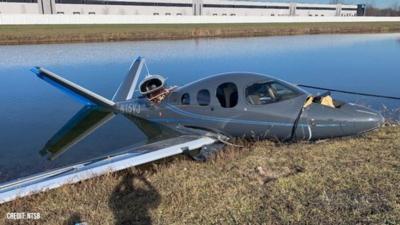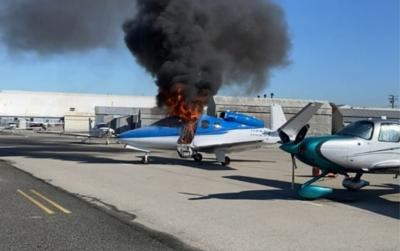No Injuries Reported in 08 February UES Mishap
On 08 February 2023 a Cirrus Vision Jet (SF50) operated by Hillandale Air LLC suffered a runway excursion after a hard landing at Waukesha County Airport (UES)—a public-use airport 1.6-nautical-miles north of Waukesha, Wisconsin.

The Waukesha County Sheriff’s Office reported the aircraft landed in such a manner that its nose-wheel touched-down on UES’s Runway 28 prior to its main landing gear. The small jet then departed the runway, coming to rest in an adjacent field. Neither of the aircraft’s two occupants—a pilot and passenger—were injured.
Waukesha County Sheriff’s Department Lieutenant Nicholas Wenzel set forth that UES remains open, is operating normally, and airport staff is working with local emergency personnel, the Federal Aviation Administration, and the National Transportation Safety Board. The latter agency, according to Lieutenant Wenzel, will disclose the mishap’s official cause “at a later date.”
The Vision Jet, registration N426SJ, reportedly departed UES bound for Tennessee’s Chattanooga Municipal Airport (CHA), but returned to land for reasons as of yet unknown—striking and departing the runway at approximately 09:56 CST.
The Vision Jet’s safety is a matter of contention in aviation circles.
The SF50 is the world’s first fully-composite jet aircraft, and the first private jet to feature a whole-aircraft parachute system. Known generally as Ballistic Recovery Systems (BRS), Cirrus has dubbed its BRS architecture the Cirrus Airframe Parachute System (CAPS).
On 09 September 2022, while on approach to Florida’s Kissimmee Gateway Airport (ISM), a Cirrus Vision Jet, registration N77VJ, encountered severe turbulence resultant of local thunderstorms. The aircraft’s pilot deployed the aircraft’s BRS, thereby initiating a descent that brought the airplane down into a marshy wooded area near the eastern shore of Lake Toho.
The aircraft’s three passengers—an adult male and female and a minor male—were transported to a nearby hospital where the woman was determined to have sustained serious but non-life-threatening injuries. The condition of the male passengers was categorized as fair.
Following the Kissimmee incident, a Cirrus company spokesperson asserted: “This is the first deployment of the CAPS on a fielded Vision Jet aircraft. We are grateful to learn of the reported outcome of the incident and our thoughts are with those involved for a quick recovery.” The spokesperson capitalized on the opportunity to point out that Cirrus’s CAPS has “returned over 230 people home safely to date” but declined to provide details about the deployments to which he alluded.
Contrariwise, on 24 August 2021, an SF50 Vision Jet—registration N1GG, operated under Part 91 of the Federal Aviation Regulations in day, VMC conditions—was destroyed in an accident at Lansing, Michigan’s Capital Region International Airport (LAN).

While departing LAN’s Runway 10R, the SF50’s pilot reported loss of left rudder effectiveness and left brake authority during the takeoff roll. The pilot elected to reject the takeoff but was unable to bring the aircraft to a stop on the remaining runway surface. During the ensuing runway excursion, the SF50 struck an airport perimeter fence, continued through a ditch, and ignited.
Notwithstanding the fierce post-accident fire and the Vision Jet’s destruction, the aircraft’s pilot and three passengers survived the accident without injuries.
President and CEO of the Capital Region Airport Authority Nicole Noll-Williams stated: “We are grateful that everyone walked away from the plane without injuries. We applaud our CRAA emergency response team and our mutual aid partners in response to the aircraft accident.”
To date, the NTSB’s investigation of the LAN SF50 accident is ongoing, with the agency’s preliminary report stating only: “The pilot reported a loss of left rudder effectiveness and left brake authority during the takeoff roll. He decided to reject the takeoff but was unable to stop on the remaining runway available resulting in a runway excursion. The airplane subsequently encountered an airport perimeter fence and a ditch.” The aircraft’s recoverable data module has been recovered and is being analyzed by the NTSB.”

On 27 December 2019, a first-generation Cirrus SF50 Vision Jet caught fire while parked at Southern California’s Santa Monica Airport (SMO). Speculation about the cause of the fire spread rapidly through the aviation community, but Cirrus, by dint of a 07 February 20020 service bulletin, ascribed the fire to: “a potential malfunction of the audio interface circuit card, which can result in excessive heat generation. There are 12 of these cards on the SF50, all of which are located in the cabin. These cards provide the audio and microphone functions to the 1/8” (3.5-millimeter) jacks located next to the passenger USB ports in the cabin; note these are not the audio/mic jacks for your aviation headset. This root cause issue will be resolved by removing the 12 circuit cards in the aircraft. We have issued Mandatory Service Bulletin SBA5X-23-03 to resolve this issue and it affects every SF50 in operation.”
Cirrus subsequently reported that within seven-days of the service bulletin’s issuance, the company’s Cirrus’s Assist mobile teams, factory, and authorized service centers had brought 97-percent of the (then) more than 170 in-field Vision Jets into compliance with the service bulletin and emergency AD.
 Unfortunate... ANN/SportPlane Resource Guide Adds To Cautionary Advisories
Unfortunate... ANN/SportPlane Resource Guide Adds To Cautionary Advisories ANN FAQ: Turn On Post Notifications
ANN FAQ: Turn On Post Notifications ANN's Daily Aero-Term (04.29.24): Visual Approach Slope Indicator (VASI)
ANN's Daily Aero-Term (04.29.24): Visual Approach Slope Indicator (VASI) ANN's Daily Aero-Term (04.28.24): Airport Marking Aids
ANN's Daily Aero-Term (04.28.24): Airport Marking Aids ANN's Daily Aero-Linx (04.28.24)
ANN's Daily Aero-Linx (04.28.24)





